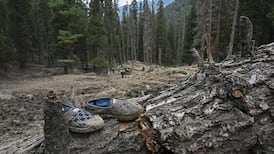Deadly enemies for more than six decades, North and South Korea’s joint commitment to “no more war” and promise to finally sign a peace treaty 65 years after the end of the Korean War marks a significant first step towards lasting regional stability.
"If we ever fight again we will die of heartbreak," South Korean president Moon Jae-in said after dinner to mark the successful signing of the joint agreement, the Panmunjom declaration, named for the peace village on the southern side of the border where the summit took place. "We have astonished the world with the speed with which we achieved this agreement."
On satirical websites, Kim is often depicted as a monolithic figure pointing at things, but during this summit he has come across as animated, self-confident and ready with a laugh.
In the way the rivals achieved a speedy closeness there were shades of Ian Paisley and Martin McGuinness, the Chuckle Brothers, and indeed the Irish peace agreement has been discussed as a possible model for Korea – the official summit website prominently features an interview with Ireland's ambassador to South Korea, Julian Clare.
There is a heady feeling of achievement, but tempering the sense of optimism is recognition that we have been here before – twice, in 2000 and 2007 – and both times North Korea has reneged on its denuclearisation promises.
When Kim's father Kim Jong-il hosted South Korea's liberal president Roh Moo-hyun in Pyongyang in October 2007, the North Korean leader handed around large glasses of burgundy and the summit produced an agreement to end hostilities, engage in dialogue and build trade ties.
Deal collapses
That deal fell apart after the North carried out a series of nuclear and missile tests. Less than two years later, Roh – a close friend of Moon – took his own life and subsequent conservative leaders have taken a hard line on the North.
What is significant this time is that the North’s leader has come to South Korea for the first time. This is a watershed moment in relations between the two Koreas and there is plenty of goodwill about.
China has congratulated the two leaders for their “courage” while the US has also backed the meeting, albeit cautiously, as it tries to assess what lies ahead for Donald Trump’s planned talks with Kim in May or June.
Paul Haenle, director of the Carnegie–Tsinghua centre for global policy, welcomed the summit's outcomes as "historic" but said they were like the opening gambits in a game of chess and more work remained to be done.
The summit raises the stakes for the forthcoming Trump-Kim summit and will ultimately put increased pressure on the US for a positive outcome.
It is not impossible that the North will still seek acceptance as a nuclear power in return for ending its intercontinental ballistic missile programme, removing the threat to mainland US, but maintaining tensions in the region.
Although the Panmunjom declaration contains steps to strengthen inter-Korean ties, it does little to pave the way for denuclearisation, Haenle said.
“It appears to use recycled language and does not contain any tangible or verifiable commitments from the North. This puts greater onus for such commitments to be made by a Trump-Kim meeting or potential quadrilateral meeting with two Koreas, US, and China,” he said.













